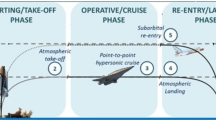Abstract
Hypersonic flight powered by airbreathing engines offers the potential for faster response time at long ranges, and reduced cost for access-to-space. In the present paper the operating environment of typical hypersonic vehicles are discussed, including results for the radiation equilibrium wall temperature of external vehicle surfaces and the flow properties through three sample engines spanning the range of hydrocarbon-fueled Mach 4-8 flight and hydrogen-fueled flight at speeds up to Mach 17. Flow conditions at several locations through the sample engines were calculated to provide indications of the required operating flow environment. Additional system consideration such a seals, joints, vehicle integration and in-service engineering are addressed.
Similar content being viewed by others
References
J. A. FAY and F. R. RIDDEL, J. Aeron. Sci. 25(2) (1958) 73.
E. R. VAN DRIEST, Jet Propulsion 26 (1956) 259.
J. D. ANDERSON, JR., “Hypersonic and High Temperature Gas Dynamics” (McGraw Hill, New York, 1989).
J. J. BERTIN, “Hypersonic Aerothermodynamics” (AIAA Education Series, Washington, 1994).
W. J. KRAWCZYK et al., AIAA-86-1596, 1986.
F. M. WHITE, “Viscous Fluid Flow” (McGraw Hill, New York, 1974).
E. J. EICHBLATT, JR., “Test and Evaluation of the Tactical Missile, ” AIAA Vol. 119, 1989.
D. M. CURRY and D. W. JOHNSON, “Orbital Reinforced Carbon/Carbon Design and Flight Experience, ” Space Shuttle Development Conference, July 1999.
W. W. TOKARSKY and R. J. DIEFENDORF, Polym. Engng. Sci. 15 (1975) 150.
R. W. BARTLETT, J. Amer. Ceram. Soc. 51 (1968) 114.
R. D. CARRAHAN, ibid. 51 (1968) 223.
R. F. VOITOVICH and E. A. PUGACH, Soviet Powder Metall. Metal Ceram. 12 (1973) 314.
V. RAMAN, R. DHAKATE and O. P. BAHL, J. Mater. Sci. Lett. 20 (2001) 315.
RUIYING LUO, ZHENG YANG and LIEFENG LI, Carbon 38 (2001) 2109.
J. MINET, F. LANGLAIS, J. M. QUENISSET and R. NASLAIN, J. Europ. Ceram. Soc. 5 (1989) 341.
L. A. FELDMAN, “High Temperature Creep Effects in Carbon Yarns and Composites, ” in Proceedings of the 17th Biennial Conference on Carbon-American Carbon Society (1985) p. 393.
K. M. PREWO, J. Mater. Sci. 21 (1986) 3590.
W. D. KINGERY, H. K. BOWN and D. R. UHLMANN, “Introduction to Ceramics” (John Wiley and Sons, New York, 1976).
Author information
Authors and Affiliations
Rights and permissions
About this article
Cite this article
Van Wie, D.M., Drewry, D.G., King, D.E. et al. The hypersonic environment: Required operating conditions and design challenges. Journal of Materials Science 39, 5915–5924 (2004). https://doi.org/10.1023/B:JMSC.0000041688.68135.8b
Issue Date:
DOI: https://doi.org/10.1023/B:JMSC.0000041688.68135.8b



